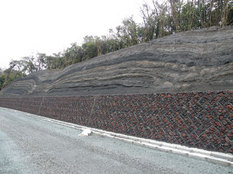Bulletin of the Geological Survey of Japan Top Page
Bulletin of the Geological Survey of Japan Vol.63 No.11/12 (2012)
Cover photograph | Table of Contents | Abstract
Cover photograph

Tephra layer of the Younger Oshima Group
Tephra layer of the Younger Oshima Group emerged due to road construction in the southeast of Izu Oshima. Thick scoria fall deposit in the central part of the outcrop is due to eruption of the Y4 (AD1421?) period.
(Photograph and Caption by Yoshihisa Kawanabe)
Table of Contents
All the pages PDF : 63_11_full.pdf [10.2MB]
| Title | Author | |
|---|---|---|
| Article | ||
| New 14C ages of the Younger Oshima Group, Izu-Oshima volcano, Izu-Ogasawara arc, Japan (This article is in Japanese, with English abstract.) |
Yoshihisa Kawanabe (283-289)
|
63_11_01.pdf [1.7MB] |
| Report | ||
| K-Ar age determinations of age-unknown rocks in the Japanese Islands -volcanic and plutonic rocks in the areas associated with Geological Map Project (fiscal 2011 version)- (This article is in Japanese, with English abstract.) |
Akikazu Matsumoto, Hitomi Nakamura, Akinari Hirota, Hideo Hoshizumi, Yutaka Takahashi, Shun Nakano and Satoshi Nakano (291-300)
|
63_11_02.pdf [2.8MB] |
| Cretaceous radiolarians from the Shimanto accretionary complex in the Kitagawa district, Tokushima Prefecture, Southwest Japan (This article is in Japanese, with English abstract.) |
Hidetoshi Hara, Kousuke Hara and Toshiyuki Kurihara (301-308)
|
63_11_03.pdf [4.4MB] |
Abstract
New 14C ages of the Younger Oshima Group, Izu-Oshima volcano, Izu-Ogasawara arc, Japan
Yoshihisa Kawanabe
New accelerator mass spectrometry (AMS) 14C ages from some tephra units of the Younger Oshima Group of Izu-Oshima Volcano were obtained. Age of the caldera forming S2 period are 1780± 50 yBP and consistent with recent AMS data obtained by other research. The age of S2 period should be revised to be in around 3rd century, about 200 to 300 years older than the previously accepted age from early 1980's. N4 period also shows about 200 to 100 years older than the previous estimated age. The ages of the other periods, N1, Y6, Y5, Y4 and Y2, are consistent with the previously estimated ages by historical records. Since the age of S2 and N4 periods became older, magma discharge rate during S to N period obtained from the tephra volume was smaller than the old estimate, but still two times higher than the magma discharge rate of Y period.
K-Ar age determinations of age-unknown rocks in the Japanese Islands -volcanic and plutonic rocks in the areas associated with Geological Map Project (fiscal 2011 version)-
Akikazu Matsumoto, Hitomi Nakamura, Akinari Hirota, Hideo Hoshizumi, Yutaka Takahashi, Shun Nakano and Satoshi Nakano
In order to construct accurate geological maps of Japan, K-Ar ages of ten igneous rocks have been determined during fiscal 2008-2011 by the geochronological laboratory of Geological Survey of Japan, AIST. The five volcanic rock samples were prepared as the groundmass fraction, in which large phenocrysts were removed as much as possible using an isodynamic separator. The phenocrysts of biotite and hornblende in five plutonic rock samples were isolated by using an isodynamic separator and heavy liquids. Each data of rock samples determined is associated with rock name, locality, collector, geological setting, K-Ar age, analytical data and geological interpretation.
Cretaceous radiolarians from the Shimanto accretionary complex in the Kitagawa district, Tokushima Prefecture, Southwest Japan
Hidetoshi Hara, Kousuke Hara and Toshiyuki Kurihara
Cretaceous radiolarians were recovered from three mudstone samples within the Shimanto accretionary complex in the Kitagawa district, Tokushima Prefecture, Southwest Japan. Two of them, red mudstone and gray mudstone, in the Osodani Unit yield radiolarian faunas indicating the ages of late Albian to Cenomanian and late Cenomanian, respectively. Black mudstone within the Taniyama Unit includes a representative radiolarian fauna presenting a Turonian age. Based on the age determination by our present data together with the radiolarian evidences reported from surrounding area, the accretionary age of the Osodani Unit is constrained to be Turonian to early Coniacian, and those of the Taniyama Unit is reinterpreted as the age of Turonian to Santonian. New findings of radiolarian fossils in the Kitagawa district help establish the age constraint for the Cretaceous Shimanto accretionary complex in eastern Shikoku.
Geological Survey of Japan, AIST
- About GSJ
- Our Activities
- Purchase guide
-
Publications and Database
- information
- Bulletin of the Geological Survey of Japan
- bull2025(Vol.76)
- bull2024(Vol.75)
- bull2023(Vol.74)
- bull2022(Vol.73)
- bull2021(Vol.72)
- bull2020(Vol.71)
- bull2019(Vol.70)
- bull2018(Vol.69)
- bull2017(Vol.68)
- bull2016(Vol.67)
- bull2015(Vol.66)
- bull2014(Vol.65)
- bull2013(Vol.64)
- bull2012(Vol.63)
- bull2011(Vol.62)
- bull2010(Vol.61)
- bull2009(Vol.60)
- bull2008(Vol.59)
- bull2007(Vol.58)
- bull2006(Vol.57)
- bull2005(Vol.56)
- bull2004(Vol.55)
- bull2003(Vol.54)
- bull2002(Vol.53)
- bull2001(Vol.52)
- Bulletin of the Geological Survey of Japan(old)
- Annual Report on Active Fault and Paleoearthquake Researches
- Reports, Geological Survey of Japan
- CCOP-GSJ Groundwater Project Report
- CCOP Technical Bulletin
- Cruise Report
- Geological Hazards
- Learning and Education
- GSJ Database Collection
- Collection of links

